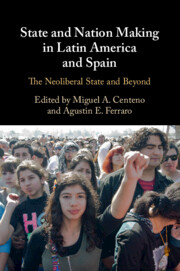Book contents
- State and Nation Making in Latin America and Spain
- State and Nation Making in Latin America and Spain
- Copyright page
- Dedication
- Contents
- Notes on Contributors
- Preface
- Part I Introduction
- Part II Economic and Territorial Power
- 2 The Chilean Neoliberal State
- 3 State, Society, and the Neoliberal Turn in Mexico, c. 1980–c. 2000
- 4 Rise of the Neoliberal State in Spain? Fiscal Shortcomings of a Popular Narrative
- 5 Guatemala
- Part III Infrastructural Power: Reform Strategies
- Part IV Symbolic Power: Identities and Social Protest
- Part V Conclusions
- Index
- References
5 - Guatemala
States and Homicidal Ecologies*
from Part II - Economic and Territorial Power
Published online by Cambridge University Press: 03 August 2023
- State and Nation Making in Latin America and Spain
- State and Nation Making in Latin America and Spain
- Copyright page
- Dedication
- Contents
- Notes on Contributors
- Preface
- Part I Introduction
- Part II Economic and Territorial Power
- 2 The Chilean Neoliberal State
- 3 State, Society, and the Neoliberal Turn in Mexico, c. 1980–c. 2000
- 4 Rise of the Neoliberal State in Spain? Fiscal Shortcomings of a Popular Narrative
- 5 Guatemala
- Part III Infrastructural Power: Reform Strategies
- Part IV Symbolic Power: Identities and Social Protest
- Part V Conclusions
- Index
- References
Summary
Homicidal ecologies are prevalent in the northern triangle of Central America, Guatemala included. This chapter contends that even with the temporal convergence of neoliberal reforms, democratization, and civil war accords, it is the persistence of historical structural factors that explain the persistence of corrupt and complicit law and order institutions that both allowed illicit organizations to thrive and failed to guarantee citizens’ basic liberal right to be free from harm. Indeed, the failure to radically change the police, the military, and the courts at the time of the peace accords has left citizens without safeguards, leading many to flee north.
- Type
- Chapter
- Information
- State and Nation Making in Latin America and SpainThe Neoliberal State and Beyond, pp. 175 - 210Publisher: Cambridge University PressPrint publication year: 2023

